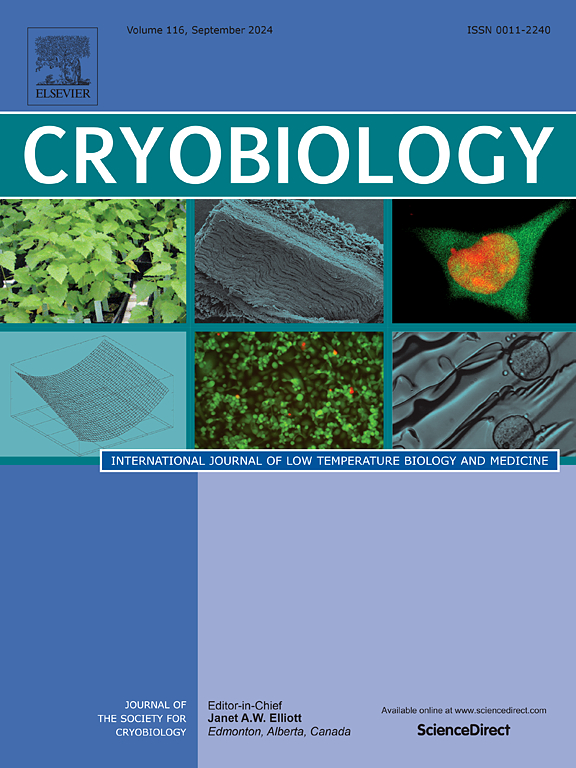The effects of various synthetic polymers on oxidative stress in ovarian tissue subjected to cryoprotectant exposure and vitrification
IF 2.1
3区 生物学
Q2 BIOLOGY
引用次数: 0
Abstract
To enhance the post-thaw viability of ovarian tissue, cryopreservation methods are continually being refined. Therefore, we aimed to explore whether ovarian tissue vitrification in closed high-security tubes could be improved with ice-blocking polymers. Bovine ovarian fragments (n = 10) were exposed to varying concentrations of a vitrification solution containing glycerol and ethylene glycol (VS1 (54 % (w/v)), VS2 (57 % (w/v)), VS3 (60 % (w/v))), supplemented with synthetic polymers (Super cool X-1000, Super cool Z-1000, and polyvinylpyrrolidone (PVP K-12)), with (VVS1, VVS2, VVS3) or without subsequent vitrification. In the second phase (n = 6), we explored the individual effects of each polymer. A lower percentage of abnormal follicles was observed in the fresh and VVS2 groups compared to other groups. Additionally, the fresh, VVS2, and VVS3 groups exhibited less tissue fibrosis than the VVS1 group. Higher tissue viability, total antioxidant levels, and lower reactive oxygen species (ROS) levels were observed in the fresh and VVS2 groups. In groups exposed to CPA, there was an increase in ROS and a decrease in antioxidants compared to the fresh group. We also observed higher tissue viability and improved follicular morphology in the vitrification solution supplemented with Super cool X-1000, either alone or in combination with PVP K-12 and Super cool Z-1000. Lower ROS were found in the group supplemented with PVP K-12, either alone or in combination with Super cool X-1000 and Super cool Z-1000. In conclusion, combining a closed vitrification system with an optimized concentration of cryoprotective agents and synthetic polymers improved bovine ovarian tissue vitrification outcomes including post thaw viability and follicular morphology when compared to standard cryopreservation protocols.
各种合成聚合物对冷冻保护剂暴露和玻璃化后卵巢组织氧化应激的影响
为了提高解冻后卵巢组织的生存能力,冷冻保存方法不断被改进。因此,我们的目的是探讨冰阻聚合物是否可以改善封闭高安全管中卵巢组织的玻璃化。牛卵巢碎片(n = 10)暴露于不同浓度的含有甘油和乙二醇的玻璃化溶液中(VS1 (54% (w/v)), VS2 (57% (w/v)), VS3 (60% (w/v)),补充合成聚合物(Super cool X-1000, Super cool Z-1000和聚乙烯吡烷酮(PVP K-12)), (VVS1, VVS2, VVS3)或不进行后续玻璃化。在第二阶段(n = 6),我们探索了每种聚合物的个体效应。与其他组相比,新鲜组和VVS2组的异常卵泡百分比较低。此外,新鲜组、VVS2组和VVS3组比VVS1组表现出更少的组织纤维化。新鲜组和VVS2组的组织活力、总抗氧化水平和活性氧(ROS)水平均较高。在暴露于CPA的组中,与新鲜组相比,ROS增加,抗氧化剂减少。我们还观察到,在玻璃化液中添加Super cool X-1000,无论是单独还是与PVP K-12和Super cool Z-1000联合,都能提高组织活力和改善卵泡形态。PVP K-12单独或联合超酷X-1000和超酷Z-1000组ROS较低。总之,与标准冷冻保存方案相比,将封闭玻璃化系统与优化浓度的冷冻保护剂和合成聚合物相结合,可以改善牛卵巢组织的玻璃化结果,包括解冻后活力和卵泡形态。
本文章由计算机程序翻译,如有差异,请以英文原文为准。
求助全文
约1分钟内获得全文
求助全文
来源期刊

Cryobiology
生物-生理学
CiteScore
5.40
自引率
7.40%
发文量
71
审稿时长
56 days
期刊介绍:
Cryobiology: International Journal of Low Temperature Biology and Medicine publishes research articles on all aspects of low temperature biology and medicine.
Research Areas include:
• Cryoprotective additives and their pharmacological actions
• Cryosurgery
• Freeze-drying
• Freezing
• Frost hardiness in plants
• Hibernation
• Hypothermia
• Medical applications of reduced temperature
• Perfusion of organs
• All pertinent methodologies
Cryobiology is the official journal of the Society for Cryobiology.
 求助内容:
求助内容: 应助结果提醒方式:
应助结果提醒方式:


